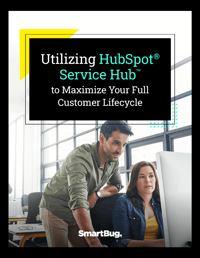
Boosting User Adoption: Strategies for a Successful HubSpot Service Hub Integration
September 9, 2024
By Paul Schmidt
You can’t maximize your full customer lifecycle without the proper systems in place. When you and your staff are fed up with user errors, inconsistent communication, and fractured workflows, you need a system that makes sense.
As part of the HubSpot CRM platform, Service Hub hosts a suite of tools and features aimed at improving customer support, satisfaction, and retention. The platform creates a seamless customer service experience by integrating customer data with CRM, marketing, and sales data for a unified view of the customer.
But a transition, even to a superior software solution like HubSpot Service Hub, doesn’t just happen. Not to mention that justifying the transition and convincing your executive leadership of the benefits of adopting new tech isn’t a simple feat.
Importance of User Adoption
Many organizations already have a tool like Service Hub in place that they’re using in conjunction with a CRM system (e.g. Zendesk, Salesforce or HubSpot). HubSpot’s Service Hub is a fully integrated help desk and customer success management tool designed to support you and your team for every stage of customer engagement. That means you get a customized and centralized customer portal for managing relationships all in one place.
Despite the benefits of Service Hub, incentivizing user adoption of a new technology isn’t a small feat. By adding new components to your customer support system, you inevitably uproot existing processes, which could disrupt operations. However, with the right approach and a few HubSpot experts on your side, you can prioritize user adoption and enable a seamless CRM integration, leading to:
- Improved customer experiences
- Enhanced productivity and efficiency
- Better data management practices and insights
- Reduced churn
- Expanded collaboration opportunities
- Increased user satisfaction
- Streamlined communication between teams
Common Challenges in User Adoption
If you lack a strategic approach to integration and adoption, onboarding a new technology opens your company up to a slew of challenges, including:
- Resistance to change
- Inadequate or irrelevant training
- Lack of motivation or user engagement
- Technical difficulties
- Limited user support
You can mitigate these common challenges by adopting the right strategies for boosting user adoption, and you can ease the transition by recruiting a certified HubSpot partner to guide you through the process.
Gaining Buy-in from Stakeholders
Before starting the implementation, however, it’s crucial that everyone in the company is onboard, particularly executive leadership. When trying to sell decision makers and department heads on switching to HubSpot Service Hub, start by addressing the following concerns.
Speak to Scalability
HubSpot Service Hub helps scale customer support operations without a corresponding increase in costs by utilizing automation and self-service tools such as knowledge bases, workflows, and chatbots. The system prioritizes continuous improvement to support the development of a long-term strategy because client service leaders can effortlessly review automation workflows, leverage AI features for support, and train staff on new features.
Emphasize Compliance Capabilities
Especially when dealing with industries such as healthcare or finance, compliance (e.g., HIPAA and GDPR) and security are critical concerns. By expertly handling data privacy, compliance, and security measures, HubSpot Service Hub offers reassurance that the system meets all regulatory requirements.
Expand on Change Management Potential
As head of client support, you are responsible for leading your teams through transitions and ensuring they run smoothly. This proves challenging when agents and other users are resistant to change, especially when they’re comfortable using existing systems. Change is hard. Adequately managing change in client services and support relies on having a unified, accessible platform like Service Hub to develop and implement issue resolution processes that work for and accommodate everyone.
For example, Sarah Archer, VP of Sales at ChartMogul, leveraged HubSpot’s native features to create a scalable change management strategy following the launch of a new office location. She shared her experience in an article on LinkedIn, where she stated that using Service Hub solutions internally enabled her and her team to:
- Understand how to better serve customers
- Determine how well they resolve issues
- Report on relevant trends
- Promote new functionality to their HubSpot user base
- Build more effective onboarding material for new team members
Acknowledge the Support Agent’s Perspective
One huge benefit of adopting Service Hub is that it reduces the day-to-day friction for support agents. The platform can make their jobs easier by streamlining workflows, improving ticket visibility (because all CRM and support data lives in one system), enabling faster resolution times, or reducing repetitive tasks through automation. Thus, Service Hub reduces burnout by making ticket management easier, and it helps support agents in working smarter. This is particularly beneficial for leadership teams that need a better way to balance high service levels with agent well-being.
Boosting User Adoption Throughout Implementation
Partnering with the right HubSpot-accredited provider increases your chances of a successful software integration because they have the expertise and capacity to optimize each stage of implementation. They can work with you to maximize user adoption efforts throughout the process, including:
1. Preparing for Integration
The first step in almost any plan is to define your goals and expectations for the project. Not only do these objectives need to be clear, they also need to align with the overall needs of the business. What are you hoping to accomplish with a Service Hub implementation? Identify those goals and address any foreseeable obstacles you may face with relevant teams.
Be sure that, as a business leader, you’re clarifying and elaborating on the reasoning behind this change to your teams and preparing them with the preliminary knowledge necessary to get on board. It helps to conduct a needs assessment, which consists of evaluating current processes and tools to identify gaps and opportunities for improvement. Communicate these findings to your staff and colleagues.
Once you know what you want to achieve (and why), your next step is to assemble a cross-functional team by assigning roles and responsibilities to each individual team member. A successful integration is reliant on leadership’s ability to build a strong and capable project team that has a clear understanding of its objectives and course of action.
2. Customizing HubSpot Service Hub
One reason so many companies choose HubSpot Service Hub is because of its customization potential. The platform’s features can be tailored to organizational needs through customized dashboards and reports, as well as workflow configurations and automation. Make sure teams are collaborating to develop personalized workflows and processes that make the most sense for both your business structure and staff competencies.
This episode from our Master HubSpot Service Hub YouTube series dives deeper into how businesses can use the platform’s ticket customization and workflow automation capabilities to streamline customer support requests:
Syncing with other tools and software is another crucial functionality for HubSpot integrations. Put appropriate data management protocol in place to help ensure seamless data migration to and from existing systems.
3. Training and Support
Service Hub users need to know that leadership has their back, even after migration and onboarding of the new software is complete. This requires the leadership team to develop comprehensive training programs that cover every aspect of the transition, including creating all materials and informational resources in addition to scheduling regular training sessions and workshops to acclimate users.
Equally as important as initial training is ongoing support. Users should not only have access to a knowledge base of essential information but also an experienced technical support team that can address any issues or inquiries. This includes establishing a help desk or formal support channel that users can reliably turn to with questions or concerns as they pop up.
4. Encouraging User Engagement
You can help your team members adopt Service Hub faster and easier by finding compelling methods to empower and reassure users. There are several ways that leaders can encourage user engagement from members of their organization, such as:
- Promoting the key features and benefits by sharing success stories and specific use cases
- Creating incentives for adoption such as offering rewards for active users and implementing gamified elements to training sessions
- Providing comprehensive training and onboarding programs to ensure users are comfortable and proficient with Service Hub
- Offering continuous support, resources, and updates to help users stay informed, and promptly resolve or troubleshoot any issues
- Encouraging user feedback to identify pain points and areas for improvement
5. Monitoring and Optimization
Once the integration or migration is complete, ongoing monitoring and optimization are the keys to maintaining user engagement and performance. Keep track of user adoption by measuring and recording usage statistics, as well as analyzing feedback and user satisfaction. Some specific KPIs that you should be monitoring during and after implementation in order to monitor ongoing performance include:
- Resolution times
- Ticket volumes
- Customer satisfaction scores (CSAT)
- Average time to first response
The most challenging part of the transition may be behind you, but continuous improvement should be an actionable and perpetual goal of leadership. This means iterating based on user feedback, making a point to regularly update and enhance the platform to work better for your organization as needs change.
How HubSpot Service Hub Helps Customers
We’ve spent a lot of time discussing how HubSpot Service Hub can benefit your sales reps and leadership team in an attempt to boost user adoption across the organization. However, Service Hub offers even more reasons to get on board in the ways it helps and supports your customer base.
Proactive Customer Support
Service Hub supports proactive customer service by leveraging data and automation to reach out to customers before issues arise (e.g., for renewals or usage drops). This can be especially attractive to leaders focused on reducing churn and increasing customer satisfaction.
Personalized Experiences
The platform's unified customer view means support agents can provide more personalized solutions because this feature allows them to see details such as customer history, preferences, and past issues.
Self-Service Options
Lastly, users can configure and optimize a self-service portal using HubSpot Service Hub by integrating with a knowledge base to provide self-service options for customers. This reduces ticket volumes while empowering customers to solve their own problems.
What Thoughtful Implementation Looks Like
With the right customer service strategies and a thoughtful implementation of HubSpot Service Hub, you can increase productivity and efficiency, reduce churn, grow loyalty, and drive better business outcomes. But you can’t achieve these things without strategic user adoption efforts aimed at making implementation as seamless and rewarding as possible.
Turn to SmartBug for help utilizing HubSpot Service Hub to maximize your full customer lifecycle.

About the author
Paul Schmidt is a director of services strategy at SmartBug Media. He previously worked at HubSpot, helping develop inbound strategies for over 200 clients. His past clients include: Travelers Insurance, Unilever, and the SABIAN Cymbal Company. Paul studied percussion in Las Vegas and got his MBA in marketing in Boston Read more articles by Paul Schmidt.








